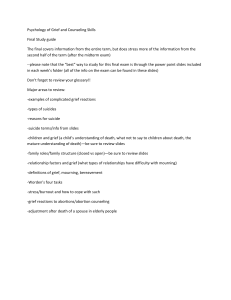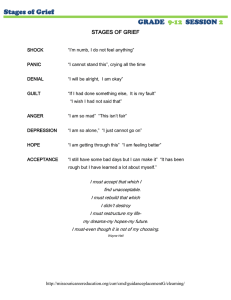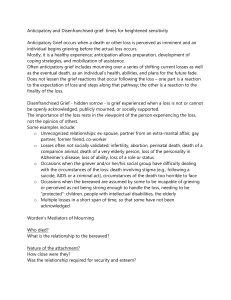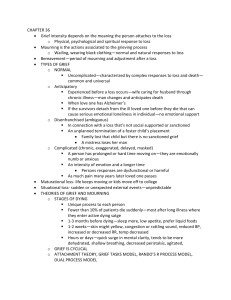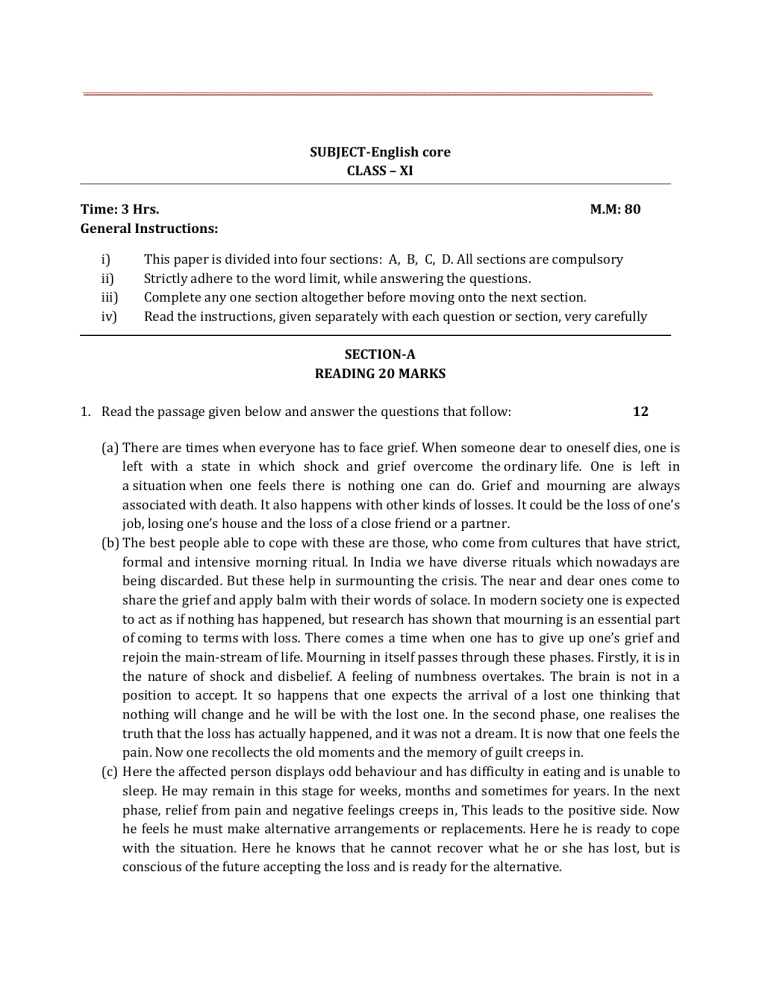
SUBJECT-English core CLASS – XI Time: 3 Hrs. General Instructions: i) ii) iii) iv) M.M: 80 This paper is divided into four sections: A, B, C, D. All sections are compulsory Strictly adhere to the word limit, while answering the questions. Complete any one section altogether before moving onto the next section. Read the instructions, given separately with each question or section, very carefully SECTION-A READING 20 MARKS 1. Read the passage given below and answer the questions that follow: 12 (a) There are times when everyone has to face grief. When someone dear to oneself dies, one is left with a state in which shock and grief overcome the ordinary life. One is left in a situation when one feels there is nothing one can do. Grief and mourning are always associated with death. It also happens with other kinds of losses. It could be the loss of one’s job, losing one’s house and the loss of a close friend or a partner. (b) The best people able to cope with these are those, who come from cultures that have strict, formal and intensive morning ritual. In India we have diverse rituals which nowadays are being discarded. But these help in surmounting the crisis. The near and dear ones come to share the grief and apply balm with their words of solace. In modern society one is expected to act as if nothing has happened, but research has shown that mourning is an essential part of coming to terms with loss. There comes a time when one has to give up one’s grief and rejoin the main-stream of life. Mourning in itself passes through these phases. Firstly, it is in the nature of shock and disbelief. A feeling of numbness overtakes. The brain is not in a position to accept. It so happens that one expects the arrival of a lost one thinking that nothing will change and he will be with the lost one. In the second phase, one realises the truth that the loss has actually happened, and it was not a dream. It is now that one feels the pain. Now one recollects the old moments and the memory of guilt creeps in. (c) Here the affected person displays odd behaviour and has difficulty in eating and is unable to sleep. He may remain in this stage for weeks, months and sometimes for years. In the next phase, relief from pain and negative feelings creeps in, This leads to the positive side. Now he feels he must make alternative arrangements or replacements. Here he is ready to cope with the situation. Here he knows that he cannot recover what he or she has lost, but is conscious of the future accepting the loss and is ready for the alternative. (d) On passing through all the stage of grief it seems that time has passed like a river under the bridge. This shows that mourning has been successful. He cannot forget the loss but comes to terms with reality. (e) Grieve with the person who is bereaved. This shows that you too value the mourned person. This gives a helping support and the bereaved person starts believing you. Your support to the bereaved should not stop after a few days. It may be needed for months. Assure the affected person that the feelings of grief diminish and it will not be the same always. (f) You will see, there comes a time when he has to be distracted from grief. Take him out for an outing, especially away from the current situation. If he agrees, take the opportunity and let him join the leisurely ventures. (g) It is, therefore, the duty of close relatives and friends to take the bereaved out of the depressing climate and give a fresh air of life and happy thoughts. 1.1. Answer the following multiple choice question. (i) In the last phase of grief: (a) There is a relief from pain and negative feelings. (b) There is still pain and grief (c) The person is ready to cope with the situation , ready to face reality (d) Both (a) and (c) (ii) One must grieve with the person who is bereaved to show: (a) That you too value mourned person (b) To distract him/her (c) You understand what your duty is (d) You are his/her will-wisher (iii) The person from grief displays? (a) Sleeplessness (b) Enjoys eating (c) Difficulty in eating (d) Both (a) and (c) (iv) On passing through all the stages of grie: (a) Time passes smoothly (b) Time passes with difficulty (c) Problems increase with time (d) All of the above 5 (v) The duty of close relatives and friends is to: (a) Help the bereaved financially (b) To take the bereaved into difficulty (c) To take the bereaved out of difficulty (d) To mourn with the bereaved 1.2. Answer the following questions: 4 (1) What are grief and mourning associated with? (ii) What type of people are able to cope up best with grief and morning? (iii) Briefly explain the first phase of mourning. (iv) How can close relative and friends help a bereaved person in coming out of his grief? 1.3. Which words in the passage mean the same as the following: 3 (i) Overcome (para 2) (ii) Shows (para 3) (iii) A short enjoyable trip (para 6) 2. Read the following passage carefully and answer the questions that follow: The work of the heart can never be interrupted. The heart’s job is to keep oxygen-rich blood flowing through the body. All the body’s cells need a constant supply of oxygen, especially those in the brain. The brain cells live only four to five minutes after their oxygen is cut off, and death comes to the entire body. The heart is a specialized muscle that serves as a pump. This pump is divided into four chambers connected by tiny doors called valves. The chambers work to keep the blood flowing round the body in a circle. At the end of each circuit, veins carry the blood to the right atrium, the first of the four chambers. Its oxygen has been used up and it is on its way back to the lung to pick up a fresh supply and to give up the carbon dioxide it has accumulated. From the right atrium the blood flows through the tricuspid valve into the second chamber, the right ventricle. The right ventricle contracts when it is filled, pushing the blood through the pulmonary artery, which leads to the lungs. In the lungs the blood gives up its carbon dioxide and picks up fresh oxygen, then it travels to the third chamber, the left atrium. When this chamber is filled, it forces the blood through the mitral valve to the left ventricle. From here it is pushed into a big blood vessel called aorta and sent round the body by way of arteries. Heart diseases can result from damage to the heart muscle, the valves or the pacemaker. If the muscle is damaged, the heart is unable to pump properly. If the valves are damaged, blood cannot flow normally and easily from one chamber to another, and if the pacemaker is defective, the contractions of the chambers will become un-co-ordinated. Until the Twentieth century, few doctors dared to touch the heart. In 1953, all this changed. After twenty years of work, Dr. John Gibbon of U.S.A. had developed a machine that could take over temporarily from the heart and lungs . Blood could be routed through the machine, bypassing the heart so that surgeons could work inside it and see what they were doing. The era of open heart surgery had begun. In the operating theatre, it gives surgeons the chance to repair or replace a defective heart. Many patients have had plastic valves inserted in their hearts when their own were faulty. Many people are being kept alive with tiny batteryoperated pacemakers; none of these repairs could have been made without the heart-lung machine. But valuable as it is to the surgeons , the heart-lung machine has certain limitations . It can be used only for a few hours at a time because its pumping gradually damages the blood cells. (a) On the basis of your reading of the above passage, make notes on it using recognizable abbreviations wherever necessary. Use a format you consider appropriate. Supply a suitable title. 5 (b) Find words from the passage which mean the same as: 3 (i) Obstructed (ii) Collected (iii) Restrictions SECTION B: WRITING 20 MARKS 3. You are Isha of R.K. memorial Sr. Sec. School. Gurgaon. As the cultural secretary of your school, write a notice for your school notice board inviting names for the excursion trip to Goa planned in the last week of September. Give all relevant details. 4 OR Draft a poster on ‘No to Plastic Bags’. 4. New India Anoderses, A-10 Phase-II, Mayur Vihar, New-Delhi, advertised regarding, the vacancy for the post of an accountant. In response to it, apply for the post giving your Bio-Data. You are Saran/Saranya of Lajpat Nagar, New Delhi. 6 OR You are Tarun, a resident of 86 New Basti Gwalior, Write a letter to the editor of ‘The Times of India’ telling about the nuisance of loudspeakers in your area. 5. Write an article for your school magazine, justifying the need of education for all in the country for national development. 10 OR Write a speech to be delivered in the school assembly on ‘Importance of Discipline’ in life. SECTION C GRAMMAR 10 MARKS 6. Make corrections wherever necessary. Write ‘No Error’ against the sentence which doesn’t need any correction. 4 (a) He usually is going to school at 7 a.m. (b) The clerk has already typed the letter before the Principal summoned him to do so. (c) They will talk for hours sitting at the bridge doing nothing. (Past habit) (d) All citizen of Indian enjoys certain fundamental rights conferred on them by the constitution. 7. In the following passage a word is missing in the line against which a blank is given. Find out the place where you think the word is missing and write the word that comes before and after it: 4 Have you ever seen banyan tree? The banyan (a) __________ __________ must be biggest tree founded in India. A full (b) __________ __________ grown banyan is as high as three storeyed building. (c) __________ __________ We do not see banyan in cities. They are so huge that (d) __________ __________ they grow only in open places. Banyan looks like (e) __________ __________ palace standing on pillars. It does not have (f) __________ __________ just main trunk like others do. It has many (g) __________ __________ roots coming down. These hanging roots enter ground (h) __________ __________ and look like smaller trunks. 8. Look at the sentences given below in a disorderly form. Re-order (Rearrange) them to form meaningful sentences. 2 (1) report/tomorrow/shall/he/for/duty. (2) lay down/my lifefl will/my motherland/ for/ of/the sake. (3) will/please/you/the window/open ? (4) work hard/to pass/the examination/should/we SECTION D LITERATURE 30 MARKS 9. Read the extract given below and answer the questions that follow by using the most appropriate options in your answer-sheet: When did my childhood go? Was it when I found my mind was really mine. To use whichever way I choose, Producing thoughts that were not those of other people But my own and mine alone Was that the day! (a) Who is the speaker? (i) An infant (ii) An adult (iii) An old man (iv) A child (b) The poet realises that he has become____ (i) Individualistic (ii) Possessive (iii) A person who thinks for himself (iv) All the above (c)The poet lost his childhood after becoming______ (i) A hypocrite (ii) Individualistic (iii) Independent (iv) Rational OR Now she’s dead nearly as many years As that girl lived. And of this circumstance There is nothing to say at all Its silence silences. (a) ‘She’s been dead refers to the 3 (i) Poet’s mother (ii) Poet’s friend (iii) Poet’s sister (iv) Poet’s aunt (b) The poetic device used in It silence silences’ is____ (i) Simile (ii) Personification (iii) Paradox (iv) Metaphor (c) What was the age of ‘that girl’ in the photograph? (i) Fifteen (ii) Fourteen (iii) Thirteen (iv) Twelve 10. Answer any three of the following questions 9 (i) Why does the rain call itself ‘eternal”? (ii) Why did the grandmother not like the teaching of English School? (iii) Why did the narrator of the story want to forget the address? (iv) What ultimatum does Mrs. Pearson give to her family? 11. Answer the following questions in about (120 words). 6 What did Carter do to remove mummy from the coffin? Why? OR How human actions have made this earth a patient? 12. Answer the following questions in about 120 words. 6 How was Ranga treated when he returns to his village from Bangalore? What does this tell about the people of Hosahalli? OR Why was Dr. Andrew horrified when he saw the condition of the child? Why 13. Attempt either Section A or B. (A) What made Booker proud of the race to which he belonged? OR The author’s motto to as: “Do not do what others can do as well.” comment. (B) Describe Virginia as the harbinger of love and peace. OR What was the history behind the blood stain? What efforts were made by the ghost to repair it?


